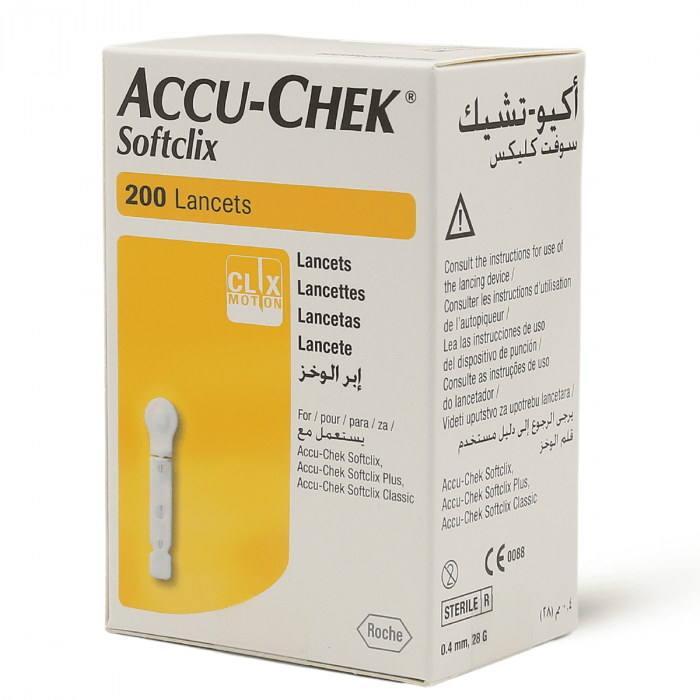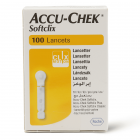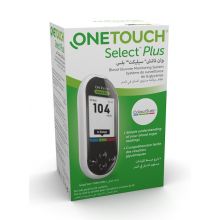Accu Chek, Softclix Lancets Get Blood Sample To Measure Blood Glucose Level - 200 Pcs
Collect 27 Arbahi Points with this purchase | Silver
you can buy using 2111 Arbahy points
Buy with 475 pts of Qitaf
- Accu Chek, Lancet, Softclix To Get A Blood Sample To Measure The Blood Glucose Level - 200 Pcs
Product Name
- Medical Devices - Diabetic Lancets
Category
- The Accu-Chek Softclix lancing device can help make lancing easy.
- Its rotatable cap offers 11 fixed depth settings for different skin types.
- Clixmotion technology minimizes any painful side-to-side motion of the lancet, which is why this lancing device is virtually pain-free to use
Uses
- Virtually pain-free lancing
- Clixmotion technology controls the lancet’s movement
- Less side-to-side motion of the lancet means less skin damage
- Turn the rotatable cap for 11 penetration depth settings for different skin types
- The Accu-Chek Softclix lancets are precisely manufactured for precise entry
Product characteristics
- Wash and thoroughly dry your hands. Warming your finger can sometimes help to increase blood flow.
- Insert a test strip into your meter.
- Use the needle (lancet) to prick the side of your fingertip.
- Gently squeeze and/or massage your fingertip until a round drop of blood forms on your fingertip.
- Line up the test strip with the blood drop then gently touch the channel to the edge of the blood drop
- After a little delay, the meter will show your blood sugar level on a screen.
- Remove the used strip from its edges, and use alcohol swabs to clean your finger
How To Measure Blood Glucose Level
- Diabetes Mellitus is a chronic disease characterized by either don't have enough insulin or insulin doesn't operate properly, increasing blood glucose levels.
- Types of diabetes:
What is Diabetes Mellitus?
- Type 1, in which the pancreas does not produce any insulin at all.
- Type 2, in which the pancreas produces insufficient insulin, or insulin stops functioning properly.
- Gestational diabetes is a temporary condition in which women's insulin becomes less effective during pregnancy.
- Common symptoms of diabetes:
- Frequent urination.
- Severe thirst.
- Severe hunger.
- Lack of attention and loss of focus.
- Tingling of hands and feet.
- Slow wound healing.
- All carbohydrate affects blood glucose levels so it’s important to know which foods contain carbohydrates. Choose the healthier foods that contain carbs and be aware of your portion sizes.
- Eat less salt. Eating lots of salt can increase your risk of high blood pressure, which in turn increases the risk of heart diseases and stroke. And when you have diabetes, you’re already more at risk of all of these conditions.
- Eat more fruit and vegetable. This can help you get the vitamins, minerals, and fiber your body needs every day to help keep you healthy.
- You can always try low or zero-calorie sweeteners (also known as artificial sweeteners) to help you cut down sugar for example steviana sweetener or tropicana sweetener
- Don’t forget to keep moving. Being more physically active goes hand in hand, with controlling blood glucose levels, with eating healthier.
- Remember to measure your blood glucose level continuously by using a home monitor
- Thiozac capsules & neurobion tablets will help you to reduce neuropathy induced by diabetes
- If you experience symptoms of hypoglycemia such as weakness, dizziness, increased sweating, fast heart beating, vision disorders, or difficulty in concentration, it usually helps to eat or drink something containing sugar.
Non-Pharmacological Treatments & Advice For Diabetic Patients
- Random blood sugar test: A blood sample will be taken at a random time. Regardless of when you last ate, a blood sugar level of 200 milligrams per deciliter (mg/dL) or higher suggests diabetes. A blood sugar level of less than 140 mg/dL is normal. A reading between 140 and 199 mg/dL indicates prediabetes
- Fasting blood sugar test. A blood sample will be taken after an overnight fast. A fasting blood sugar level of less than 100 mg/dl is normal. A fasting blood sugar level from 100 to 125 mg/dL is considered prediabetes. If it's 126 mg/dL or higher on two separate tests, you may have diabetes.
- Oral glucose tolerance test: For this test, you fast overnight, and the fasting blood sugar level is measured. Then you drink a sugary liquid, and blood sugar levels are tested periodically for the next two hours.
Normal Ranges
| Size | 200pcs |
|---|---|
| Brand | ACCU-CHECK® |
| Is Bonded | No |
| Bonded Types | None |
| Product Function | Blood Sampling |
| Product Form | Lancets |
| Gender | Unisex |
| Features | Disposable |




